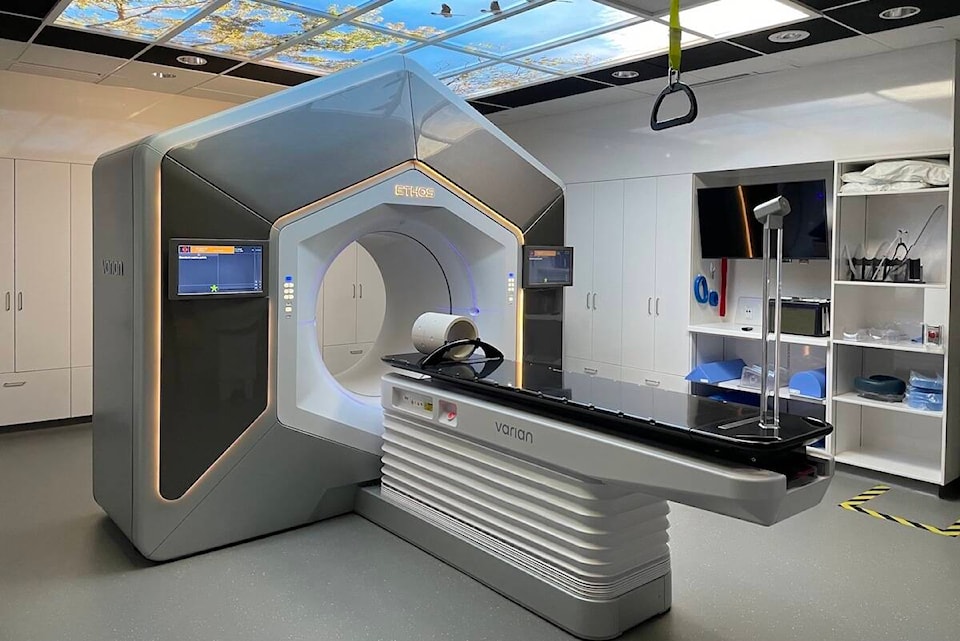Cancer radiation treatments are becoming faster thanks to a new machine in Kelowna that’s the first of it’s kind in Canada.
BC Cancer Kelowna has the first Ethos adaptive radiation therapy unit in Canada, making the process and the planning of treatments easier and faster.
With both older machines and the new Ethos machine, radiation treatments only take anywhere from 30 seconds to two minutes but the new machine quickens the planning process exponentially.
With the older machines, radiation treatment is the same everyday, and when, for example, someone’s tumor gets smaller, the team of doctors has to create a new plan that could take days to make and put in place.
With the new Ethos machines, a new plan, customized to each patient, is built in 15-20 minutes and the computer instantly starts creating the next plan once the radiation treatment for that day is complete.
“12 years ago, you wouldn’t imagine making a treatment plan everyday,” said Senior Physical Therapist Nathan Becker.
Bachand added that the machine does around 80 per cent of the work while they complete the other 20 per cent.
While radiation machines have been around for a long time now, this is the first that is brand new to the industry.
“The older [machines] are 60’s, 70’s 80’s technology and they’ve done a lot of add-ons over time,” said Becker. “This machine is built from the ground up, it’s been built to be as streamlined as possible.”
It’s been a long process not just for BC Cancer Kelowna, but for cancer centres around the world to use this new technology. This machine got FDA approved in 2020 and approved by Health Canada around a year ago. Before it was even approved, the Kelowna centre was looking at purchasing one. When the technology got approved by Health Canada, Kelowna was in line to purchase the machine.
Kelowna’s centre started training on the machine on Dec. 12 and have been treating patients on it for three weeks now. While this is currently the only clinical machine in Canada, meaning its the only one in use, Newfoundland also has one they will be launching soon and Vancouver is expected at get two machines either late in 2023 or early in 2024. There are also a few hundred machines in use in the United States and because the technology is still so new, the Kelowna Cancer Centre is in constant communication with the research groups in America talking around strategy and techniques with the machine and side effects from patient to patient. A clinic in Europe also has five of the machines.
—
On top of being able to plan quicker and make the actually treatment a little faster, the hope is patients will experience less side affects with this machine as well. Because of the technology, the machine is able to be more precise, therefore affecting less organs in the process.
“For the patient experience in general should be improved,” said Bachand. “Because you can identify the structures that you’re trying to protect everyday, we hope the patients will experience less side effects and recover faster. We don’t really know for sure that that will make a certain difference. It would make sense but we’ll see that in the coming years because it does takes a while before you can really look back and see how patients did. It doesn’t take long to see how patients do on treatment but how they recover and if there’s any side effects six or 12 months later.”
Whether the machine is old or new, the centre is able to treat 30 patients a day but are hoping they are able to treat more in a day with the tech machine. Because its still so new, it’s too early to tell.
Each year, the Kelowna centre has 2,700 new cancer patients that require radiation.
And while this machine is the lately and greatest, the older machine are still effective in eliminated one’s cancer as some machines are tailored to different types of cancer.
“This is a tool in our arsenal,” said Becker “You don’t necessarily five Ferraris in your garage. This is the Ferrari of our treatment machines.”
—
One someone comes in to receive their treatment, it’s a complex process with a lot of moving parts.
“There’s a lot of people involved,” said Yendley.
In each treatment, there is at the minimum, two radiation therapists, radiation oncologist, and medical physicist.
With the new machine, patients can go inside and get themselves into the machine to make sure their information is correct, then the team of doctors begins the set up for radiation. With the radiation goes on, the team is outside controlling the machine, making sure everything is in place, and is able to see and talk to the patient.
Before the machine arrived, the cancer centre renovated the place, including adding a back room that’s specifically for training purposes with the new machine. Because each treatment is time sensitive, the team running the operation stays in there positions while doctors and students who are learning sit in the back room and can also see the process through the camera that doctors are watching through.
“I think the learning curve is pretty quick at the moment,” said Bachand. “I feel strongly that we’ll be able to contribute to these other centres as well with introducing new techniques, it’s going really well.”
READ MORE: Former Nakusp doctor, now living in Kelowna, disciplined for sex with patient
@cunninghamjordy
jordy.cunningham@kelownacapnews.com
Like us on Facebook and follow us on Twitter.



